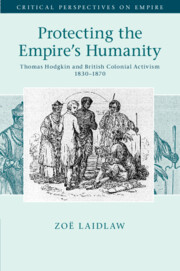Book contents
- Protecting the Empire’s Humanity
- Critical Perspectives on Empire
- Protecting the Empire’s Humanity
- Copyright page
- Dedication
- Contents
- Figures
- Maps
- Acknowledgements
- Abbreviations
- 1 Introduction
- Part I Mapping Humanitarianism
- Part II Humanitarianism and Settler Colonialism
- 6 Making Colonization Civilizing
- 7 Dealing with the Devil
- 8 Conscripts of Civilization
- 9 Betrayal in the Borderlands
- 10 Conclusion
- Bibliography
- Index
8 - Conscripts of Civilization
North American Networks
from Part II - Humanitarianism and Settler Colonialism
Published online by Cambridge University Press: 14 September 2021
- Protecting the Empire’s Humanity
- Critical Perspectives on Empire
- Protecting the Empire’s Humanity
- Copyright page
- Dedication
- Contents
- Figures
- Maps
- Acknowledgements
- Abbreviations
- 1 Introduction
- Part I Mapping Humanitarianism
- Part II Humanitarianism and Settler Colonialism
- 6 Making Colonization Civilizing
- 7 Dealing with the Devil
- 8 Conscripts of Civilization
- 9 Betrayal in the Borderlands
- 10 Conclusion
- Bibliography
- Index
Summary
North America was a key nineteenth-century battleground for indigenous rights. The Aborigines’ Protection Society followed US developments keenly; derided and despaired of the rule of the monopolistic Hudson’s Bay Company in Rupert’s Land; and hoped that the Canadian colonies could lead the way in recognizing indigenous rights. This chapter considers the society’s championing of indigenous rights in British North America at a time of imperial withdrawal. It explores the emphasis placed by the Aborigines’ Protection Society on ‘civilization’, and how this was shaped by Thomas Hodgkin’s encounters with four indigenous activists from British North America. The Ojibwa chief and missionary, the Reverend Peter Jones and his niece, Nahnebahwequa, protested the theft of their land and advocated for indigenous education, representation and legal rights. Alexander Isbister and his uncle, William Kennedy, spearheaded the campaign in Britain against the Hudson’s Bay Company. The chapter explores how indigenous interlocutors’ engaged with British humanitarians; how their authority translated to the metropolitan context; and how this translation jeopardized standing at home.
Keywords
- Type
- Chapter
- Information
- Protecting the Empire's HumanityThomas Hodgkin and British Colonial Activism 1830–1870, pp. 238 - 279Publisher: Cambridge University PressPrint publication year: 2021

